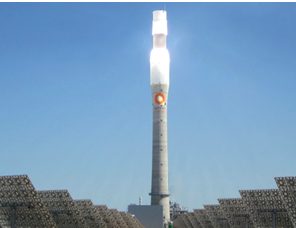As a combined clean energy package, concentrating solar power with storage is “virtually unbeatable” – and the costs are coming down. And if you’re shooting for 100% renewables, well then it’s essential.
That was the (perhaps predictable) message from Dr Keith Lovegrove, head of solar thermal energy at ITPower, speaking on day two of the All Energy Australia conference in Melbourne.
Citing AEMO’s 2013 study on 100% renewables, Lovegrove reckons the electricity grids of today can take on “an awful lot of variable stuff” under the renewable energy umbrella, as long as they have storage and baseload. And proven solar thermal energy storage – most commonly in the form of two-tank molten salt storage – along with the ability to provide baseload generation, is CSP’s “big competitive advantage.”
On top of this, the technology offers green electricity, a greater share of investment in regional areas, the deferment or avoidance of network upgrades, and the possible hybridisation with fossil fuel plants – although, Lovegrove says, the way things are going “I would suggest this is not the main game.”
And according to a 2012 study by ITP, around 15GW of CSP could be realistically installed in Australia without a major grid expansion.
The barriers? Well, proven though it is, as a technology concentrating solar power is still coming up in the energy world. Lovegrove estimates that, deveoplmentally, it is around 10 years behind solar PV.
“It occasionally gets heard about,” he told the conference. As we know, it’s big in Spain, with the two-year anniversary of the Seville Gemasolar plant delivering a record 36 days of round-the-clock energy generation. And it’s about to be big in the US – “this week, if not yesterday!” Lovegrove told the conference on Thursday, referring to two CSP plants currently entering commissioning phase: Abengoa’s Solarna project and Solar Reserve’s Crescent Dunes project in Nevada), adding a combined 400MW of CSP with storage to the US total.
As for Australia, we will get our first “serious” CSP plant with the completion of the Kogan Creek project in Queensland – a 44MW solar thermal booster to a 750MW coal power plant (part of a fossil fuel retrofitting experiment that Lovegrove can’t see taking off: “Oh, well, there are a few shiny things on a coal plant, but where does it take you?”). For Australia to really get in on the solar thermal game, he said, it will need to build its first large stand-alone CSP plant with storage, to build confidence and experience.
What’s stopping us? Could be the fact that CSP is still cost prohibitive, with the LCOE of the average plant with storage sitting at around $250/MWh (2012) – more than double the average revenue generated (as at 2012), at $110/MWh. But according to ITP estimates, revenue and costs for CSP could intersect within six to eight years. And according to modelling by ITP, CSP with molten salt storage (10 hours) and solar power towers (100MW) could cut the price to $176/MWh almost immediately.
This is the beauty of solar thermal technology, says Lovegrove. “Adding storage has effectively worked to improve solar energy efficiency. If you can get hot tank hotter you can store more energy, making the energy delivery more cost-effective.”
And that’s what a solar power tower – which will be best exemplified by the coming Crescent Dunes plant in the US – does: increases the heat of the molten salt storage, boosting the amount of solar thermal energy that can be stored.
“Thinking purely about storage for renewables, CSP with storage could deliver 30-40% better efficiency with extra heat,” Lovegrove said. “You might as well suck up extra energy generation and return it at 30-40% improved efficiency.”
And, he adds, “a system configured for peaking could earn twice the average pool price.”










